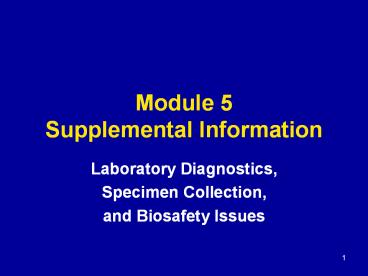Module 5 Supplemental Information - PowerPoint PPT Presentation
1 / 17
Title:
Module 5 Supplemental Information
Description:
Only test samples that were packed during transport ... Indirect IF Staining of Cells From Tracheal Aspirate. Anti-H5. Anti-A/NP. Anti-H3. Anti-B ... – PowerPoint PPT presentation
Number of Views:64
Avg rating:3.0/5.0
Title: Module 5 Supplemental Information
1
Module 5Supplemental Information
- Laboratory Diagnostics,
- Specimen Collection,
- and Biosafety Issues
2
Laboratory Diagnosis of Avian Influenza
3
Laboratory Diagnosis for Avian Influenza
- Only test samples that were packed during
transport - Only test samples with identification information
- Use positive and negative controls for all tests
4
Laboratory Diagnosis for Avian Influenza
- Tests for respiratory samples
- Virus isolation
- PCR-based techniques
- Immunofluorescence
- Rapid antigen detection
- Blood sera used for
- Measurement of specific antibodies
- Viral isolation
- PCR-based techniques
5
Virus Isolation
- Gold standard for detection of avian influenza
- Allows identification of virus and test for drug
susceptibilities - Technically difficult and requires BSL-3
laboratory
6
PCR-based Techniques
- Examples nested reverse transcriptase polymerase
chain reaction (RT-PCR) and real-time RT-PCR - Sensitivity depends on the particular test, the
influenza strain, and the type of specimen used - Sensitivity 80 - 100
- Specificity 90 - 100
7
Immunofluorescence
- Works best on clinical specimens collected
immediately after symptoms begin - Results will tell you whether a particular
influenza virus is present - Sensitivity and specificity not established
8
Indirect IF Staining of Cells From Tracheal
Aspirate
Anti-H5
Anti-H3
Anti-A/NP
Anti-B
Taken from World Bank Training by Alexander
Klimov, CDC
9
Rapid Antigen Tests
- Detects influenza A and B virus
- Detects human strains of influenza
- Limitations
- Not yet used to test for avian influenza
- Specificity and sensitivity not yet established
10
Serology Tests
- Used to confirm infection because it takes
several weeks to get results - Useful when the sample is taken too late for
virus isolation - Sensitivity and specificity of 80 - 100
11
Serology Tests
- Types
- Haemagglutination inhibition test
- Enzyme immunoassay
- Virus neutralization test
- Western Blot
12
Serological Tests
- Paired serum samples are most useful
- Acute sample
- Within 7 days after symptom onset
- Convalescent sample
- More than 12 days after symptom onset
13
When Single Samples are Appropriate
- 1. Convalescent samples collected in outbreak
investigations of novel viruses (such as H7 or
H9) - Single samples collected in convalescent phase
are compared to age-matched controls
14
Interpreting Serology Tests
15
How to Avoid Misinterpretations
- Use positive and negative controls
- Make sure you understand what the test is
identifying - Use multiple tests to confirm results
16
Laboratory Practice Exercise
17
References and Resources
- Recommended laboratory tests to identify avian
influenza A virus in specimens from humans. World
Health Organization, June, 2005.
http//www.who.int/csr/disease/avian_influenza/gui
delines/avian_labtests2.pdf - WHO guidelines for the collection of human
specimens for laboratory diagnosis of avian
influenza infection, 12 January 2005.
http//www.who.int/csr/disease/avian_influenza/gui
delines/humanspecimens/en/index.html - Infection control for viral haemorrhagic fevers
in the African health care setting.
WHO/EMC/ESR/98.2 Section 6 Dispose of Waste
Safely http//www.who.int/csr/resources/publicatio
ns/ebola/WHO_EMC_ESR_98_2_EN/en/index.html































